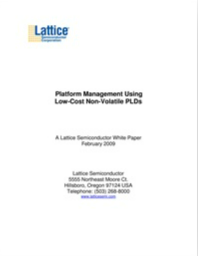Platform Management Using Low-Cost Non-Volatile PLDs
Power-up control, general purpose I/O expansion, voltage level translation and interface bridging are common functions in telecom infrastructure, server and industrial applications. System designers are turning to the use of programmable logic devices (PLDs) to implement these functions in their designs due to the inherent time-to-market and design flexibility advantages they offer over ASICs and ASSPs.
By using PLDs in their designs, designers can respond to changing market standards and requirements within a compressed window of opportunity.
Download this whitepaper to find out more.
Read More
By submitting this form you agree to [publishpress_authors_data field="display_name" post_id="$ID"] contacting you with marketing-related emails or by telephone. You may unsubscribe at any time. [publishpress_authors_data field="display_name" post_id="$ID"] web sites and communications are subject to their Privacy Notice.
By requesting this resource you agree to our terms of use. All data is protected by our Privacy Notice. If you have any further questions please email dataprotection@techpublishhub.com
Related Categories: Automotive, Communication, Components, Embedded, Industrial, Power, Switches

